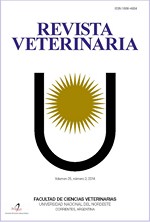Comparing two simple cryopreservation methods for porcine sperm. Effect on sperm quality parameters
DOI:
https://doi.org/10.30972/vet.3013893Keywords:
Porcine, sperm, cryopreservation, sperm qualityAbstract
About 40% of red meat consumed around the world is porcine meat. Argentinean producers face the big challenge of achieving productive improvements with efficient and sustainable economic development and reproductive technologies, like artificial insemination and sperm cryopreservation (that still has many problems in this specie), seems to be an essential element for achieving them. The aim of this work was to compare two different simple cryopreservation methods for porcine sperm, evaluating sperm quality parameters at the moment of thawing. Sperm samples were cryopreserved following Peña et al. protocol (2003), performing (treatment group) or not (control group) a modification during the final step of cryopreservation after the straws’ packing. Sperm motility and viability of ejaculated and thawed sperm were evaluated by optic microscopy with thermal stage and the combination of the blue trypan supravital technique and differential interferential contrast microscopy, respectively. Cryocapacitation was evaluated by the chlortetracycline technique (CTC). The results of the different experiments were analyzed by t-student test. The samples of the treatment group showed a significantly higher (p<0.05) sperm motility and a significantly lower (p<0.05) cryocapacitation than the control group. The percentage of live spermatozoa in samples of the treatment group (33±3) doubled those in the control group (16±2). Our results demonstrate that the proposed method of cryopreser enfriavation allows obtaining, at thawing, higher quality sperm samples than the ones obtained with the traditional method of cryopreservation.
Downloads
Downloads
Published
How to Cite
Issue
Section
License
Copyright (c) 2019 M C. Pérez, A Petrinelli, P C. Rodríguez, M M. Satorre, E Breininger

This work is licensed under a Creative Commons Attribution-NonCommercial 4.0 International License.
Revista Veterinaria (Rev. Vet.) maintains a commitment to the policies of Open Access to scientific information, as it considers that both scientific publications as well as research investigations funded by public resources should circulate freely without restrictions. Revista Veterinaria (Rev. Vet.) ratifies the Open Access model in which scientific publications are made freely available at no cost online.











.jpg)
.jpg)



